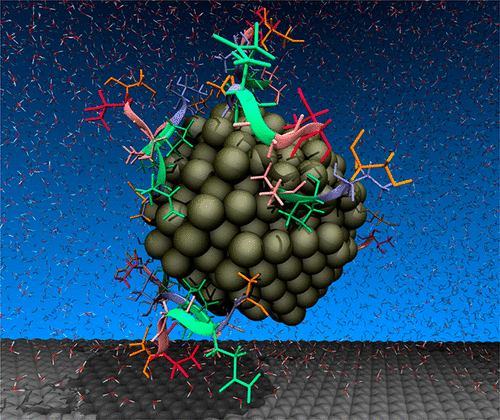当前位置:
X-MOL 学术
›
Acc. Chem. Res.
›
论文详情
Our official English website, www.x-mol.net, welcomes your
feedback! (Note: you will need to create a separate account there.)
Pathways to Structure–Property Relationships of Peptide–Materials Interfaces: Challenges in Predicting Molecular Structures
Accounts of Chemical Research ( IF 16.4 ) Pub Date : 2017-06-30 00:00:00 , DOI: 10.1021/acs.accounts.7b00065 Tiffany R. Walsh 1
Accounts of Chemical Research ( IF 16.4 ) Pub Date : 2017-06-30 00:00:00 , DOI: 10.1021/acs.accounts.7b00065 Tiffany R. Walsh 1
Affiliation

|
An in-depth appreciation of how to manipulate the molecular-level recognition between peptides and aqueous materials interfaces, including nanoparticles, will advance technologies based on self-organized metamaterials for photonics and plasmonics, biosensing, catalysis, energy generation and harvesting, and nanomedicine. Exploitation of the materials-selective binding of biomolecules is pivotal to success in these areas and may be particularly key to producing new hierarchically structured biobased materials. These applications could be accomplished by realizing preferential adsorption of a given biomolecule onto one materials composition over another, one surface facet over another, or one crystalline polymorph over another. Deeper knowledge of the aqueous abiotic–biotic interface, to establish clear structure–property relationships in these systems, is needed to meet this goal.
中文翻译:

肽-材料界面的结构-属性关系的途径:预测分子结构中的挑战
对如何操纵肽和水性材料界面(包括纳米粒子)之间的分子水平识别的深入了解,将推动基于自组织超材料的技术发展,这些材料用于光子学和等离激元,生物传感,催化,能量产生和收集以及纳米医学。生物分子对材料的选择性结合的开发对于在这些领域取得成功至关重要,并且对于生产新的层次结构的生物基材料可能尤其重要。这些应用可以通过将给定生物分子优先吸附在另一种材料组合物,另一种表面的另一面或另一种晶体的多晶型物上来实现。对水性非生物-生物界面有更深的了解,
更新日期:2017-06-30
中文翻译:

肽-材料界面的结构-属性关系的途径:预测分子结构中的挑战
对如何操纵肽和水性材料界面(包括纳米粒子)之间的分子水平识别的深入了解,将推动基于自组织超材料的技术发展,这些材料用于光子学和等离激元,生物传感,催化,能量产生和收集以及纳米医学。生物分子对材料的选择性结合的开发对于在这些领域取得成功至关重要,并且对于生产新的层次结构的生物基材料可能尤其重要。这些应用可以通过将给定生物分子优先吸附在另一种材料组合物,另一种表面的另一面或另一种晶体的多晶型物上来实现。对水性非生物-生物界面有更深的了解,











































 京公网安备 11010802027423号
京公网安备 11010802027423号